|
|
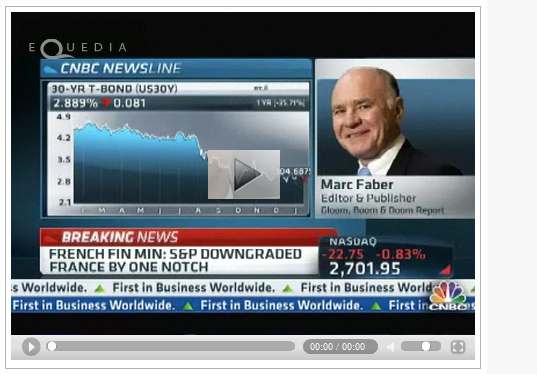 | | click to play |
Featured Video European Woes Continue
A massive case of Euros-sis continues to plague the markets as downgrade threats continue. So how does this affect our market?
Watch the video as Marc Faber, editor and publisher of the Gloom, Boom & Doom Report, discusses the S&P downgrade of France and other European countries and hear his latest rant on global monetization wars.
|
|
Dear Readers,
The world is confused. The world is overleveraged. And the world continues to explode with new supplies of fiat currency. What's next?
I often turn to some of the world's greatest investment minds for their opinion. Earlier this week, I was watching an interview with the world's biggest bond fund manager, Bill Gross. Big bond fund managers are some of the smartest people in the world at predicting and understanding the overall global economic outlook.
"We're very worried [about the global economy]. Aside from recent action in risk markets, which has been very good, we think the global economy and the global financial markets are at risk in 2012 due to a number of reasons.
Basically, we're suggesting instead of the normal, bell-shaped curve, we're talking about two fat tails: the one of re-flation, which is what the markets are anticipating at the moment - a significant input of reserves and credit from the central banks - and on the other hand, a significant left fat tail of deflation in which policies promoted by the ECB, the Bank of England and the Fed (through Twist) ultimately don't convince the private market to take the bait and continue to buy risk assets and believe in a thriving economy."
For the past year, and in particular last week, I have mentioned there is nothing the world governments can do to avoid printing money. Given the circumstances, both the ECB and the Fed will do what they have to in terms of expanding base money and providing sovereign credit that ultimately expands the asset bubble - leaving the central banks completely overleveraged. As a fundamental banking rule, a bank should typically be eight-to-one, or nine-to-one in terms of its leverage. But if you look at the central banks of the world as one individual bank and include the shadow banking system on top of that, the central banks of the world are really 18 to 20 times leveraged, according to Bill Gross.
Anytime the banking system is overleveraged, it adds to deflationary pressures as the banks look to deleverage - the same deflationary pressures that central banks want to avoid. Most people don't understand the central banks' primary concern is not inflation - it is keeping over-leveraged insolvent banks afloat through a period of private sector credit deflation.
The world banks will avoid deflation at almost any cost. The problem is there is no solution to fix our economies instantly as there is nowhere near enough income to service debt at any level. So the central banks will have no choice but to expand asset purchases through QE's and ultimately centralize and sovereign-ize the private banking system.
The new head of the European Central Bank, Mario Draghi, just told us rates will remain low for an extended period - following directly in the footsteps of the Fed's policy of suppressing interest rates for as long as possible. This is just a precursor to more money printing.The world is confused because it has no idea if we're deflating or inflating.
Nothing Has Changed
Back in February 2011, I wrote in The Shocking Truth that the US ranked 190th in the World in current account balance - dead last in the 190 countries tracked. The account balance is a country's net trade in goods and services, plus net earnings from rents, interest, profits, and dividends, and net transfer payments (such as pension funds and worker remittances) to and from the rest of the world during the period specified.
It's been nearly one full year and that number hasn't changed one bit, nor will it anytime soon. The US is still dead last with countries such as Haiti, Kosovo, Uganda, Rwanda, Zimbabwe, and Vietnam all having better balances than the US.
While the account balance has improved for the US and currently sitting at minus $470,200,000,000, China remains the number one spot by improving its numbers to a positive $305,400,000,000. That's a difference of $ 775,600,000,000 - nearly one trillion dollars.
Take a look at this picture that shows a world map of public debt as a percentage of GDP: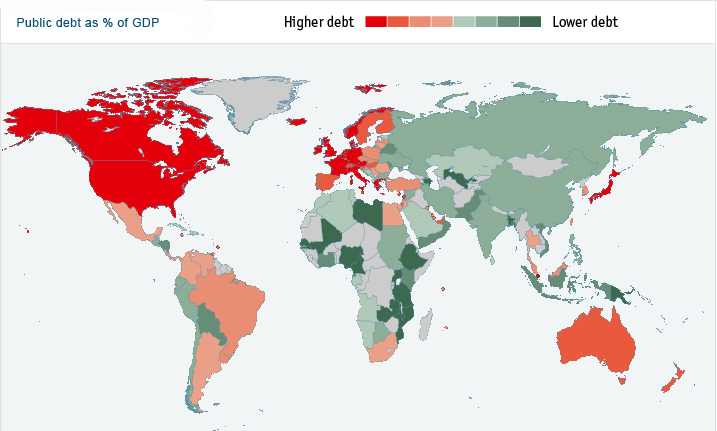 Pretty straight forward. The redder the colours, the more public debt to GDP a country has. Notice that Canada, US, Japan, Autralia and the European nations have the highest levels of public debt to GDP.
The whole world is riddled with debt. Every powerhouse country's debt to GDP ratio are exceeding the Rogoff & Reinhart's 90% point of no return (countries with debt beyond 90% simply cannot grow.) including Germany, France, U.K., and the U.S. Japan has already been off the charts for some time, with debt well exceeding 200% of GDP. Keep in mind these figures are just for the official government debt. If countries were required to report their debt like a corporation, their unfunded entitlement promises to future generations are four to six times more than their official government debt.
Most of this debt well never be serviced.
The US is adding $3.7 billion per day to the National Debt, which is equal to more than $1.3 trillion per year and growing. It has already surpassed the 100% to GDP mark. By the time the US has a new president, the National Debt will be over $16.5 trillion. 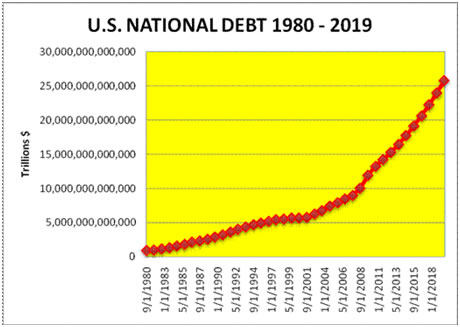 Want to know why Bernanke and the Fed have decided to keep short term interest rates near zero? Interest on the National Debt in 2011 was an all-time high of $454 billion with an effective interest rate at approximately 3%. However, each percentage increase in rates would cost American taxpayers an additional $150 billion. From 1971 until 2010 the United States' average interest rate was 6.45 percent. If interest rates ever return to the historical average, it would take more than $1 trillion to service the interest on the national debt. Complete Faith
For the last five years, I have been putting my complete faith into gold and silver. During this time, the world's debt level and money supply has risen exponentially and this trend is only getting worse as I just mentioned.
As a result, gold has continued its decade long bull run. This won't change because governments around the world won't - I mean can't - change. Anyone who says gold has collapsed back into a bear market is wrong. Gold is merely correcting in a bull market.
Practically every central bank is churning out paper money like there's no tomorrow and using the money to buy up even more gold for their own vaults. That's because gold is real money and the world's only real safe currency. No central bank has ever been able to print gold, except for exchanging their own currency for the metal.
Back in December (see The Eurozone's Banking Secret), I mentioned that gold purchases by the central banks have already been reaping the benefits of exchanging currency for bullion. As an example, Switzerland's central bank said on Oct. 31, 2011 it returned to a profit in the first nine months as gold holdings helped counter losses on currency reserves. This week, the bank announced it had profited 13 billion Swiss francs ($13.8 billion) with 5 billion of it as a result of its gains in gold holdings. The central banks won't stop printing money. They won't stop buying gold either. So while you are busy saving up cash that they are so mindlessly creating from thin air, they are busy using it to buy gold. Don't be a sucker.
If you think $2000 gold is the mania, you haven't seen nothing yet.
Disclosure: I am long gold and silver through ETF's and bullion, as well as long both major and junior gold and silver companies.
Until next week, Ivan Lo Equedia Weekly 
Questions?
Call Us Toll Free: 1-888-EQUEDIA (378-3342)
|
|

 The US Government Is Bankrupt The US Government Is Bankrupt
By Doug Casey, Casey Research
Everyone knows that the US government is bankrupt and has been for many years. But I thought it might be instructive to see what its current cash-flow situation actually is. At least insofar as it's possible to get a clear picture.
As you know, the so-called Super Committee recently tried to come up with a plan to cut the deficit by $1.5 trillion and failed completely. To anyone who understands the nature of the political process, the failure was, of course, as predictable as it was shameful. What's even more shameful, though, is that the sought-after $1.5 trillion cut wasn't meant to apply to the annual budget but to the total budget of the next 10 years - a fact that is rarely mentioned.
Now whenever the chattering classes talk about cuts, it's always about cuts over the course of 10 years. Which is a dodge, partly because most of the supposed cuts will be scheduled for the end of the period, but also because new programs, new emergencies and hidden contingencies will creep in to offset any announced cuts. So the numbers below aren't a worst case; they're the rosiest possible scenario. People have thought I was joking when, asked how bad the Greater Depression was going to be, I answered that it would be worse than even I thought it would be. But I haven't been joking.
To sum up the situation, given its financial condition and the political forces working to worsen it, the US government is facing a completely impossible and irremediable situation. I'm going to try to illustrate that here. But because I'm a perpetual optimist, not a gloom-and-doomer, I'm also going to give you solutions to the purely financial problems - albeit with some good news and some bad news. The good news is, there actually are solutions. The bad news is that there is zero chance that any of them will be put into effect.
The problems are one hundred percent caused by the US government, not by bankers, brokers or the real estate industry - although they have been complicit. Recall what government is: an organization with a monopoly of force within a certain geographical area. Its purpose is, ostensibly, to protect the inhabitants of its bailiwick from the initiation of force. That implies three functions: an army to protect against aggressors coming from outside of its borders; police to protect citizens from aggressors inside its borders; and a court system to allow citizens to adjudicate disputes without resorting to force. Assuming you're going to have a government, it's important to limit it strictly, lest it get completely out of control - it's got a monopoly of force, after all - and overwhelm the society it's supposed to protect.
Here I want you to distinguish government from society. They are not only two totally different things, but are potentially antithetical to each other. This is because the essence of government is force, not voluntary cooperation. Everything that people think the government provides (beyond some forms of protection) is really provided by society or with resources the government has taken from society. It's critical to understand this, or you won't see the slippery slope the US is now sliding on.
Is there any chance that the US government can reform and go back to a sustainable basis at this point?
Click Here to Continue Reading
More Casey Research Articles
> India: Land of Energy Opportunity
|
|
Calendar Call Spread: A Neutral to Bullish Strategy
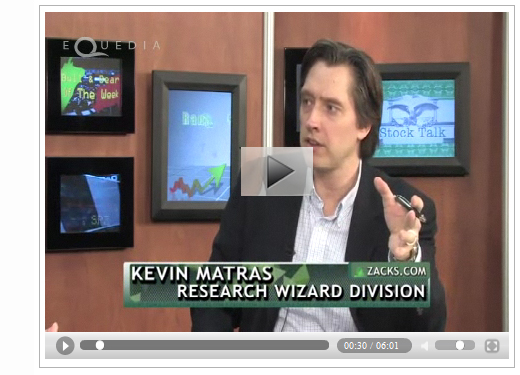 | | click to play |
Even if you aren't that familiar with options, I'll bet you've heard some one use the term 'calendar spread'.
Whether they knew what they were talking about is another story.
So let's define it here.
A Calendar Spread (also known as a 'time spread' or 'horizontal spread') is when you sell (write) an option in one month and buy an option with the same strike price but in a different, further out month.
Watch the video as Kevin Matras shows how you can profit from this easy to implement strategy, even in sideways markets.
Click Here to Continue Reading or Watch the Video
More Zacks Videos:
> Strong Stocks and Industries Immune to Europe > Will Europe Show Up in Earnings Season? > Get Ready To Be Surprised This Earnings Season > Earnings Growth Expected to Decelerate > Bull & Bear for the Week -- January 12, 2012 > Growth & Income Stock Picks featuring analyst research on Brinker International (EAT) and Tanger Factory Outlet Centers (SKT) Video - January 11, 2012 > Value Stock Picks with analyst research on Oriental Financial Group (OFG) and Huntsman Corp. (HUN) - January 10, 2012 |
|
| Featured BNN Clip:
BNN: Sino Forest Update - Click to Read
|
The Dollar's Lucky Streak
By: Peter Schiff
 Recent U.S. economic data, such as the modest drop in the unemployment rate and the massive expansion of consumer credit, have suggested that the American economy is finally recovering. Opposite conclusions are being thrown at Europe, where many are convinced that recession is returning. Not surprisingly then, the dollar is currently hitting a multi-year high against the euro. The strength of the dollar itself is often held up as one of the major proof points that the U.S. economy is "improving." But the data points that I believe really matter continue to suggest an economy on life support. I believe that the dollar is rising for reasons that have nothing to do with America's economic health. Recent U.S. economic data, such as the modest drop in the unemployment rate and the massive expansion of consumer credit, have suggested that the American economy is finally recovering. Opposite conclusions are being thrown at Europe, where many are convinced that recession is returning. Not surprisingly then, the dollar is currently hitting a multi-year high against the euro. The strength of the dollar itself is often held up as one of the major proof points that the U.S. economy is "improving." But the data points that I believe really matter continue to suggest an economy on life support. I believe that the dollar is rising for reasons that have nothing to do with America's economic health.
The ongoing sovereign debt crisis in Europe is unquestionably the center ring in the current economic circus. Given the difficulty of setting policy across borders and national interests, the negotiations in Europe have been messy, acrimonious, inconclusive, and conducted under the glaring lights of global media scrutiny. The action has diverted attention away from America's problems, which in many ways are even greater than those in Europe. In contrast, America's ability to print the world's currency at will, and the nearly seamless agreement of policy between the Administration and the Federal Reserve, means that the United States has been able to virtually ignore the issues that Europe has been forced to confront. This relative calm has been mistaken for strength, and the dollar has beckoned as the ultimate safe haven currency. The fact that the dollar is perceived as a safe haven acts as a self-fulfilling prophesy. Investors flee the euro and pile into dollars. The dollar then rises to reflect the demand. The increase validates the decision to buy in the first place, and the rising dollar then attracts even more buyers looking to profit from its appreciation. It's a nice ride while it lasts. Most "safe haven" dollar purchases are directed toward U.S. Treasuries. As a result U.S. interest rates are far lower than they would otherwise be without this inflow of spooked liquidity. But objectively speaking, the U.S. and Italy, for instance, have very similar national debt profiles. Yet interest rates in Washington are currently 600 basis points lower than they are in Rome. This means that Americans can borrow and spend much more. The result of all this extra debt financed consumption is...
|
Technical Trading with Harry Boxer
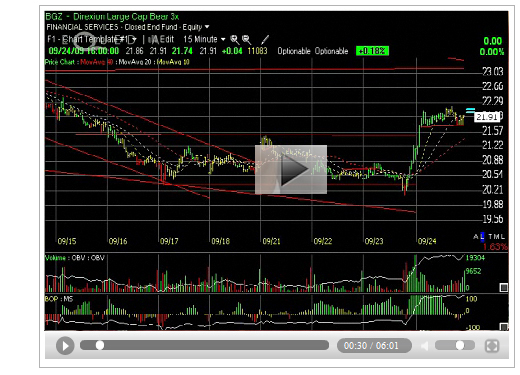 | | click to play |
Harry has more than 40 years of Wall Street investment and technical analysis experience, including eight years on Wall Street as chief technical analyst with three brokerage firms. Watch the January 12th video as he walks you through his technical analysis on a whole bunch of stocks he thinks you should be watching from last week. To see more videos, Click Here. |
|
Upload Your Own Videos - Embed Videos
Is there a video on Youtube or another website that you want to post without uploading it through our technology?
With our new Embed feature enabled, you can now upload and embed any object or video into your blog post. Many of our users are already embedding videos from Fox, Youtube, and CNBC and sharing them with our users.
Embedding is simple. Just copy and paste the embed codes from another website ino the main blog section of your post (not the exceprt).
Where do you find these embed codes?
Embed codes for videos are usually right beside a video.
Here is an example of where the code is on Youtube, highlighted in yellow:
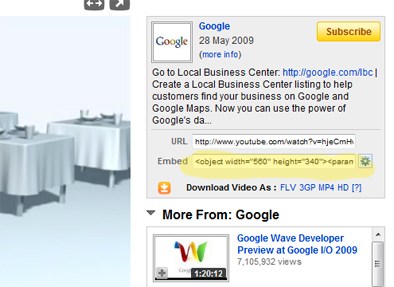
So share what you find with everyone! To learn more, feel free to email or call us at 1-888-EQUEDIA
|
|
Equedia Tips - The Markets Tab
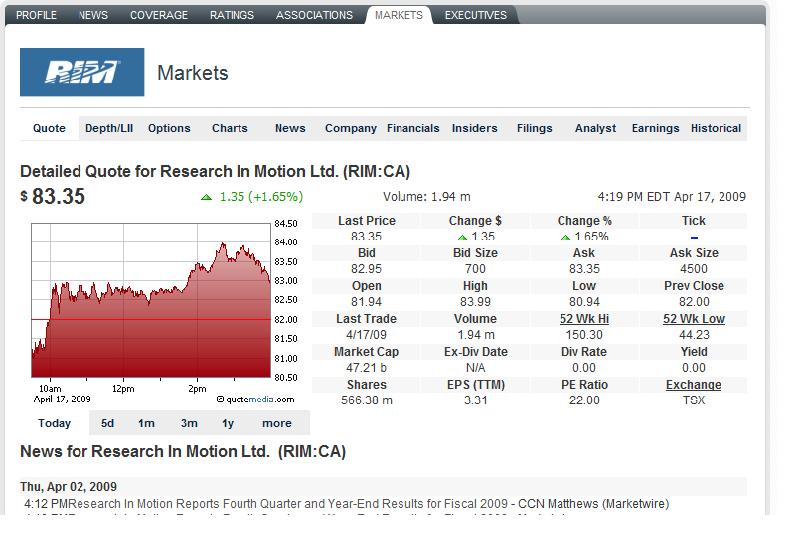
Using the search function at the top right corner of the website, search for any company. Let's use Research in Motion as an example. Once you reach their profile page, click on the MARKETS TAB. You should now see 12 seperate tabs underneath their logo. Try clicking on them and you will find in-depth information such as:
Detailed Quotes - Depth/Level II - Options - Java Charts - News - Profile - Financials - Insiders trades - Filings - Analyst Consensus - Earnings - Historical Data (Highs/Lows, Volumes, Closing/Opening Prices)
|
|
Additional Features (you may not know)
Equedia has many features (you may have overlooked) that will help you manage your investment life and ensure a more enjoyable and useful experience.
Here are just a few of them:
Calendar subscriptions: Keep track of your business events, subscribe to other events, and have access to your online calendar from anywhere in the world. In the near future, we will be working with public companies to add their events to the calendar so that shareholders will never miss an important event again. So call your companies and get them to participate!
Tagging companies to videos and images: Did you know that all of your videos and images can be tagged to public companies? Do you have a video about Google? How about a blog with an image? How about just a blog? Tag it to Google in your blog post, so that anyone searching for Google's quotes and finances can find your coverage!
Buy, Sell, and Hold Ratings: Once you log in, you can submit your buy, sell and hold ratings on the ratings tab so that other shareholders can see what YOU think. You may also access your associates' ratings and see what they think of the shares you hold.
Blog feed subscriptions: Once you add someone as an associate, you will have access to all of their blog posts through your blog feeds. Simply go to your "blog feeds" tab once you log in!
Search function: By far one of the most overlooked but important functions on Equedia. Using the top right hand corner search function, you can find and add any corporations, media users, or investors to your network.
Markets Tab: Under any corporate profile, you will find this tab. Under this tab, you can find the company's news, level 2 depth (delayed), options, charts, profile, financials, insider trades, filings, analyst overviews, earnings, and historical data (these may not be available for all companies)
There are many more useful features on Equedia.com but we think its better if you experience them for yourself. The more associates you have, the more useful Equedia will become for you. So use the new "invite my contacts" function and get started!
|
Forward-Looking Statements
Except for the statements of historical fact, the information contained herein is of a forward-looking nature. Such forward-looking information involves known and unknown risks, uncertainties and other factors which may cause the actual results, performance or achievement of the Company to be materially different from any future results, performance or achievements expressed or implied by statements containing forward-looking information.
Although the Company has attempted to identify important factors that could cause actual results to differ materially, there may be other factors that cause results not to be as anticipated, estimated or intended. There can be no assurance that statements containing forward looking information will prove to be accurate as actual results and future events could differ materially from those anticipated in such statements. Accordingly, readers should not place undue reliance on statements containing forward looking information. Readers should review the risk factors set out in the Company's prospectus and the documents incorporated by reference.
Cautionary Note to U.S. Investors Concerning Estimates of Inferred Resources
This presentation uses the term "Inferred Resources". U.S. investors are advised that while this term is recognized and required by Canadian regulations, the Securities and Exchange Commission does not recognize it. "Inferred Resources" have a great amount of uncertainty as to their existence, and great uncertainty as to their economic and legal feasibility. It cannot be assumed that all or any part of an Inferred Resource will ever be upgraded to a higher category. Under Canadian rules, estimates of "Inferred Resources" may not form the basis of feasibility or other economic studies. U.S. investors are also cautioned not to assume that all or any part of an "Inferred Mineral Resource" exists, or is economically or legally mineable.
|
|
|
|
|
|
This Week's Most Wanted
The Stock Market's Most Interesting Videos That You Should Watch
|
 Companies Under Evaluation This Past Week
|
|
Rants and Raves
Inside the mind of Equedia's editor - unrated, uncut, and unedited
Some facts from a past newsletter:
Nearly one out of every five American men between the ages of 25 and 54 does not have a job at the moment Approximately one million homes were repossessed by financial institutions in 2010 and a similar number of repossessions is expected in 2011. The combination of federal government spending, state government spending and local government spending now accounts for a larger share of U.S. GDP than at any other time in our history The supply of existing homes for sale continues to go up The value of U.S. homes has fallen by a total of approximately 6.6 trillion dollars since the peak of the housing market The more money you make, the less taxes you pay: General Electric, the nation's largest corporation, reported worldwide profits of $14.2 billion, and said $5.1 billion of the total came from its operations in the United States. Its American tax bill? None. In fact, G.E. claimed a tax benefit of $3.2 billion. Meanwhile, citizens are being forced to pay taxes with money they don't have. Ten years ago, the United States was ranked number one in average wealth per adult. In 2010, the United States fell to seventh In 2010, the United States had the worst current account balance in the world. The U.S. had a current account balance of negative 561 billion dollars for 2010 (see The Shocking Truth) It takes the average unemployed worker about 40 weeks to find a new job. Today, one out of every four American children is on food stamps: It is being projected that approximately 50 percent of all U.S. children will be on food stamps at some point in their lives before they reach the age of 18 To date, American household wealth has lost $7.7 trillion since the recession: U.S. household wealth fell by about $16.4 trillion of net worth from its peak in spring 2007, about six months before the start of the recession, to when things hit bottom in the first quarter of 2009, according to figures from the Federal Reserve. While a rebound in the stock market, an improved savings rate and consumer steps to reduce debt resulted in net worth gains since 2009, only a little more than half of that lost wealth - $8.7 trillion -- is back on household balance sheets. That leaves American household wealth $7.7 trillion less than it was before the recession. Those are just some of the little details that the US is afraid to tell you. But there's more. There's always more... Click Here to Continue |

|

|
|
|
|
Disclaimer and Disclosure
Disclaimer and Disclosure Equedia.com & Equedia Network Corporation bears no liability for losses and/or damages arising from the use of this newsletter or any third party content provided herein. Equedia.com is an online financial newsletter owned by Equedia Network Corporation. We are focused on researching small-cap and large-cap public companies. Our past performance does not guarantee future results. Information in this report has been obtained from sources considered to be reliable, but we do not guarantee that it is accurate or complete. This material is not an offer to sell or a solicitation of an offer to buy any securities or commodities.
Furthermore, to keep our reports and newsletters FREE, from time to time we may publish paid advertisements from third parties and sponsored companies. We are also compensated to perform research on specific companies and often act as consultants to many of the companies mentioned in this letter and on our website at equedia.com. We also make direct investments into many of these companies and own shares and/or options in them. Therefore, information should not be construed as unbiased. Each contract varies in duration, services performed and compensation received.
Equedia.com is not responsible for any claims made by any of the mentioned companies or third party content providers. You should independently investigate and fully understand all risks before investing. We are not a registered broker-dealer or financial advisor. Before investing in any securities, you should consult with your financial advisor and a registered broker-dealer. The information and data in this report were obtained from sources considered reliable. Their accuracy or completeness is not guaranteed and the giving of the same is not to be deemed as an offer or solicitation on our part with respect to the sale or purchase of any securities or commodities. Any decision to purchase or sell as a result of the opinions expressed in this report OR ON Equedia.com will be the full responsibility of the person authorizing such transaction.
Again, this process allows us to continue publishing high-quality investment ideas at no cost to you whatsoever. If you ever have any questions or concerns about our business or publications, we encourage you to contact us at the email or phone number below.
Please view our privacy policy and disclaimer to view our full disclosure at http://equedia.com/cms.php/terms. Our views and opinions regarding the companies within Equedia.com are our own views and are based on information that we have received, which we assumed to be reliable. We do not guarantee that any of the companies will perform as we expect, and any comparisons we have made to other companies may not be valid or come into effect. Equedia.com is paid editorial fees for its writing and the dissemination of material and the companies featured do not have to meet any specific financial criteria. The companies represented by Equedia.com are typically development-stage companies that pose a much higher risk to investors. When investing in speculative stocks of this nature, it is possible to lose your entire investment over time. Statements included in this newsletter may contain forward looking statements, including the Company's intentions, forecasts, plans or other matters that haven't yet occurred. Such statements involve a number of risks and uncertainties. Further information on potential factors that may affect, delay or prevent such forward looking statements from coming to fruition can be found in their specific Financial reports. Equedia Network Corporation., owner of Equedia.com has been paid $6428 HST per month for 7 months which totals $45,000 plus hst of media coverage on Abzu Gold Ltd. and has been granted 100,000 options at $0.64 vesting over a one year period. Abzu Gold Ltd. has paid for this service. Equedia.com currently owns shares of Abzu Gold Ltd. and we may purchase more shares without notice, as we did after the initial release of our Abzu Gold Report. We intend to sell every share we own for our own profit. We may sell shares in Abzu Gold Ltd. without notice to our subscribers. Equedia Network Corporation., owner of Equedia.com has been paid $45,000 plus hst for a 19-month consulting agreement and 7 months of media coverage on Kiska Metals Corporation and has been granted 100,000 options at $1.35 vesting over a two year period. Kiska Metals has paid for this service. Equedia.com currently owns shares of Kiska Metals Corporation and we may purchase more shares without notice. We intend to sell every share we own for our own profit. We may sell shares in Kiska Metals Corporation without notice to our subscribers.
Equedia Network Corporation is also a distributor (and not a publisher) of content supplied by third parties and Subscribers. Accordingly, Equedia Network Corporation has no more editorial control over such content than does a public library, bookstore, or newsstand. Any opinions, advice, statements, services, offers, or other information or content expressed or made available by third parties, including information providers, Subscribers or any other user of the Equedia Network Corporation Network of Sites, are those of the respective author(s) or distributor(s) and not of Equedia Network Corporation. Neither Equedia Network Corporation nor any third-party provider of information guarantees the accuracy, completeness, or usefulness of any content, nor its merchantability or fitness for any particular purpose.
info@equedia.com
1-888-EQUEDIA

|
|
|